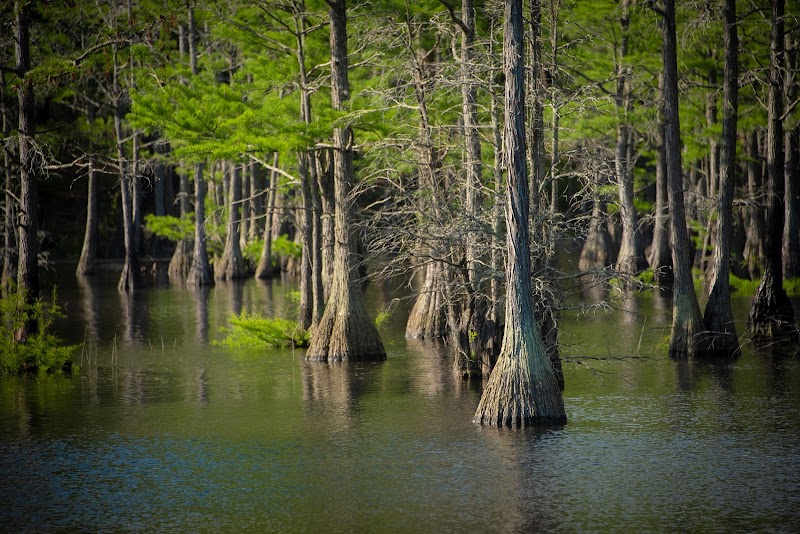
Carvers Creek State Park Adventures
Carvers Creek State Park offers a picturesque setting in North Carolina, providing diverse opportunities for hiking, fishing, and exploring historical sites. A prominent feature is its lush longleaf pine forests and historical ties to the Rockefeller family.
Popular Activities
Carvers Creek State Park, NC: An Angler's Adventure
Carvers Creek State Park in North Carolina is not just a location; it's a haven where the harmonious dance of nature and tranquility enchants the soul of every angler. As you stand at the water's edge, rod in hand, the quietude of the park whispers tales untold, offering both solace and challenge to those seeking the serene pursuit of fishing. The park boasts two distinct access points: the Long Valley Farm Road and the Sandhills Access, each offering a different tableau of experiences while connected by the common thread of the creeks and the abundant life within them.
Upon arrival, the welcoming embrace of towering longleaf pines guides your journey towards the park’s aquatic gems. Whether you're expertly casting from the banks or venturing out onto the still waters in a small boat, Carvers Creek presents an array of opportunities for beginners and seasoned anglers alike. It is here, amidst whispering leaves and sighing branches, that you may find bass lazily patrolling the waters or the playful dance of bream near the surface.
The Long Valley Farm Access, cradling a historic rockefeller estate, lends itself to fishing in the picturesque ponds where largemouth bass and elusive catfish await the skilled angler's bait. The ponds, fringed by grasses swaying in a gentle breeze, seem to encourage a patient approach, rewarding those who align their senses with nature's rhythms. The air is imbued with a refreshing crispness in the early morning, a perfect backdrop for the start of your fishing day.
Meanwhile, the Sandhills Access brings you to larger bodies of water, where both the avid and casual can engage in the timeless pursuit of catching bluegill and other sunfish varieties. The sounds of rustling leaves and the distant call of woodland creatures form an audial symphony, engrossing and utterly soothing. As your line drifts with the current, there’s a thrill in the potential for discovery, each shimmering flash beneath the water promising the next big catch.
Before setting out on this aquatic adventure, it’s crucial to prepare adequately. The park requires fishing licenses for anglers, ensuring that conservation efforts support future generations. Hydration is a must, with ample water and refreshment at hand to keep you energized through the day. Equipping yourself with the right tackle—medium-weight rods and tackle boxes stocked with versatile lures—equips you for the diverse species residing in these waters. Comfortable yet sturdy footwear is indispensable, offering support as you explore the banks or potentially traverse the slightly rugged trails connecting these fishing spots.
The best times to fish align with nature’s own rhythms; early dawn when the world stirs gently awake, or the quiet grace of dusk, as sunlight softens and day concedes to night. Weather plays its own pivotal role, and thus, checking the forecast becomes part of the ritual, preparing you for rain’s random grace or the sun’s gentle kiss.
Carvers Creek State Park doesn’t merely offer the sport of fishing; it transforms each cast and catch into part of a larger story, a rite of passage in the rich tapestry of North Carolina’s natural beauty. Each visit is an embrace of the wild simplicity and intricate elements highlighting the trophy waiting just beneath the surface. It is an invitation to those weary of the concrete cocoon of urban life to escape, explore, and in the flow of water and the rustle of the wind, perhaps find themselves anew.
Plan Your Visit
Everything you need to know to prepare for an unforgettable trip to Carvers Creek State Park.
Entrance Requirements
Free access, no permits required
Best Time to Visit
The best times to visit are in spring and fall for mild temperatures and blooming flora.
Visitor Information
No visitor center; information available at park entrances
Getting There
Accessible by road, with parking available at main entrances
Weather & Climate
Summers are hot and humid with temperatures often exceeding 90°F. Winters are mild, and the transition seasons offer cooler, more temperate weather ideal for outdoor activities.
Conservation Efforts
The park is actively involved in the conservation of the longleaf pine ecosystem and the endangered red-cockaded woodpecker. Fire management is crucial for ecosystem health.
Camping in Carvers Creek State Park
Find the perfect spot to stay overnight and immerse yourself in the details.
Top Trails
James S. Rockefeller Trail
A scenic trail that provides access to Long Valley Farm and the Rockefeller house.
Fisherman's Trail
Trail leading to good fishing spots along the park's lakes and creeks.
Cypress Point Loop
A loop offering views of the natural wetlands and diverse wildlife.
Caroline Dormon Trail
This trail traverses the park’s diverse ecosystems and scenic landscapes.
Trailblazer Tips
Visit during weekdays to avoid weekend crowds.
Summers can be hot and humid, so spring and fall are ideal for pleasant temperatures.
Check conditions of trails after heavy rains as some may be temporarily closed.
Bring binoculars for wildlife viewing, particularly for birdwatching enthusiasts.
